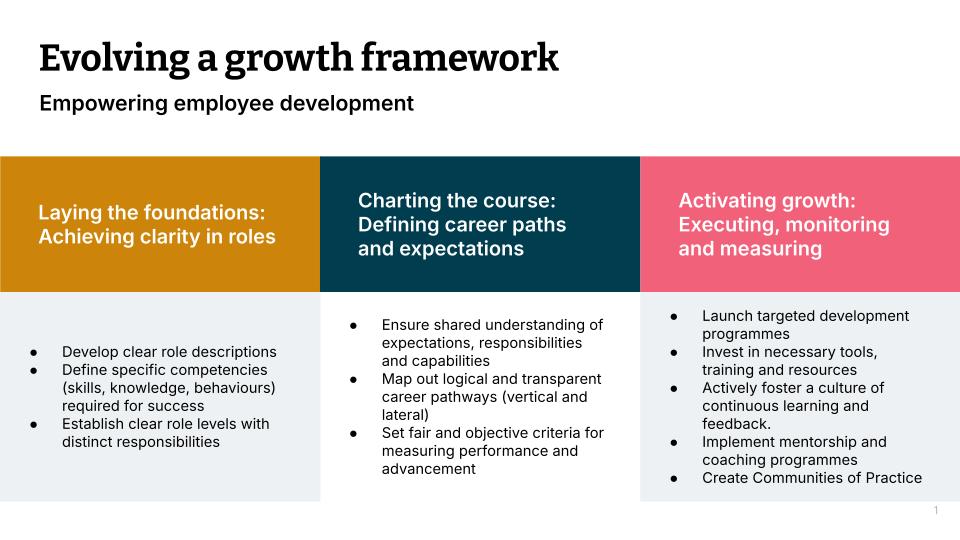Technology is evolving fast. Business models are transforming. Success now demands a workforce that’s agile, adaptable and learns continuously. People rarely join a business intending to stay there and develop their careers internally. In the US median tenure is 3.9 years. In large tech companies the tenure is usually shorter.
The continued escalation of AI usage is accelerating that change. People will embrace new opportunities and not stay in the same roles for life. This volatile environment requires a fundamental rethink of how we manage talent. How can we ensure we secure and nurture the talent we need amid this maelstrom of change? We must shift our perspective from a static career ladder to a dynamic career ecosystem. This means empowering employees with the skills and visibility to navigate diverse career pathways.
As employers’ needs change, there needs to be a corresponding change in organizations’ strategies for people and talent growth. We propose a robust talent strategy for this dynamic career ecosystem, built on a three-pillared framework, which can build a resilient, adaptable and high-performing workforce.


Pillar 1: Architecting a competency-driven roles architecture for clarity and alignment
The foundation of any modern career ecosystem is a clear, competency-driven role architecture. This is not yesterday’s static, outdated job descriptions which create significant challenges:
For the organization. Static roles hinder strategic execution by making it impossible to identify and close skills gaps at scale. This leads to inconsistent hiring, poor succession planning, and a disconnect between individual roles and broader business objectives. It also complicates benchmarking and equitable compensation.
For employees. The lack of clarity leads to perceived subjectivity in performance reviews and promotions. Employees feel a lack of control and visibility, which erodes trust and diminishes motivation.
Instead, what’s needed is a dynamic inventory of skills and behaviors required for success at every level.
The solution: Role architecture as a strategic tool
A well-defined role architecture provides a structured framework for all roles. It clarifies how each role/position contributes to shared goals, creating a transparent, consistent foundation for talent management. This is the critical first step to ensuring everyone understands their place and their path and enables organizations to identify and close latent skill gaps at scale.
In a future article we will explore in more detail what we mean by a role architecture and how to create one for your organization.
Pillar 2: Charting the course with a competency framework
Once the foundational role architecture and competency inventory is in place, the next step is to define the specific vertical and horizontal pathways for growth for each role. This is the engine of the career ecosystem.
A comprehensive competency framework:
Empowers development. Provides a clear, objective guide for career conversations and individual development planning.
Aligns strategy. Ties learning and development (L&D) initiatives directly with strategic business needs and organisational capability gaps.
Removes subjectivity. Ensures equity in performance evaluations and promotion decisions by linking progression to demonstrable competencies.
Enables mobility. Gives employees visibility into potential vertical and horizontal career pathways, giving employees visibility into potential growth opportunities across the organization and fostering a culture of internal movement and reskilling.
This framework is not just an HR tool; it’s a strategic lever that connects individual growth to organizational capabilities.
In a future article we will explore in more detail what we mean by competencies and how to create a growth framework for your organization.
Pillar 3: Activating growth through execution
The final pillar is about operationalizing the first two. It involves implementing the necessary tools, processes and cultural shifts to fully activate the competency-driven model. Execution is no longer about ‘rolling out training’, but about engineering a continuous learning system. This involves three key shifts:
Optimizing learning and development (L&D). Shifting L&D from a reactive function to a proactive, strategic force that offers targeted, competency-based learning opportunities and experiential growth.
Deploying supporting technology. Look for HR and talent management systems that can track competencies, map career paths and provide predictive analytics on skill supply and demand to generate actionable insights.
Fostering a culture of growth. Cultivating an environment where continuous learning, constructive feedback, and skills development are actively encouraged and rewarded. This is where the framework truly becomes a living part of the organizational culture.
In a future article we will explore how to implement the three-pillar approach within your organization.
The future is competency-driven
Adopting this three-pillared framework enables your organization to democratize growth, optimize talent and strategically align your workforce with business objectives. By making career paths visible and tying progression to demonstrable competencies, you not only meet the needs of the modern workforce but also create a compelling reason for top talent to stay and grow with your organization.
A competency framework is not merely a human resources initiative; it is a strategic imperative for competitive advantage. It transforms how you acquire, develop and retain talent, positioning your organization for long-term success in a rapidly changing world.
Disclaimer: The statements and opinions expressed in this article are those of the author(s) and do not necessarily reflect the positions of Thoughtworks.


















